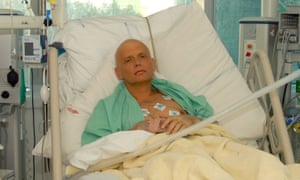Alexander Litvinenko: the man who solved his own murder
Alexander Litvinenko in the intensive care unit of University College Hospital, London, on November 20, 2006. He died three days later. Photograph: Natasja Weitsz/Getty Images Contributor
This week, the inquiry into the death of Alexander Litvinenko will deliver its findings. The former Russian spy was poisoned with a cup of tea in a London hotel. Working with Scotland Yard detectives, as he lay dying, he traced the lethal substance to a former comrade in the Russian secret service.
Luke Harding, The Guardian
Last modified on Tuesday 19 January 2016 05.36 EST
The Millennium hotel is an unusual spot for a murder. It overlooks Grosvenor Square, and is practically next door to the heavily guarded US embassy, where, it is rumoured, the CIA has its station on the fourth floor. A statue of Franklin D Roosevelt – wearing a large cape and holding a stick – dominates the north side of the square. In 2011 another statue would appear: that of the late US president Ronald Reagan. An inscription hails Reagan’s contribution to world history and his “determined intervention to end the cold war”. A friendly tribute from Mikhail Gorbachev reads: “With President Reagan, we travelled the world from confrontation to cooperation.”
The quotes would seem mordantly ironic in the light of events that took place just around the corner, and amid Vladimir Putin’s apparent attempt to turn the clock back to 1982, when the former KGB boss Yuri Andropov – the secret policeman’s secret policeman – was in charge of a doomed empire known as the Soviet Union. Next to the inscriptions is a sandy-coloured chunk of masonry. It is a piece of the Berlin Wall, retrieved from the east side. Reagan, the monument says, defeated communism. This was an enduring triumph for the west, democratic values, and for free societies everywhere.
Five hundred metres away is Grosvenor Street. It was here, in mid-October 2006, that two Russian assassins had tried to murder someone, unsuccessfully. The hitmen were Andrei Lugovoi and Dmitry Kovtun. Their target was Alexander Litvinenko, a former officer in Russia’s FSB spy agency. Litvinenko had fled Moscow in 2000. In exile in Britain he had become Putin’s most ebullient and needling critic. He was a writer and journalist. And – from 2003 onwards – a British agent, employed by MI6 as an expert on Russian organised crime.
Latterly, Litvinenko had been supplying Her Majesty’s spooks and their Spanish counterparts with hair-raising information about the Russian mafia in Spain. The mafia had extensive contacts with senior Russian politicians. The trail apparently led to the president’s office, and dated back to the 1990s when Putin, then aide to St Petersburg’s mayor, Anatoly Sobchak, worked closely with gangsters. In a week or so, Litvinenko was to testify before a Spanish prosecutor. Hence, it appeared, the Kremlin’s frantic efforts to kill him.
The men from Moscow were carrying what Kovtun confessed to a friend was “a very expensive poison”. About its properties he knew little. The poison was polonium-210, a rare radioactive isotope, tiny, invisible, undetectable. Ingested, it was fatal. The polonium had originated at a nuclear reactor in the Urals and a production line in the Russian town of Sarov. A secret FSB laboratory, the agency’s “research institute”, then converted it into a dinkily portable weapon.
Lugovoi and Kovtun, however, were rubbish assassins. The quality of Moscow’s hired killers had slipped since the glory days of the KGB. Their first attempt, in a Grosvenor Street boardroom, had not worked. They had lured Litvinenko to a business meeting, where – the radiation stain later showed – they had tipped polonium into his cup or glass. But Litvinenko did not touch his drink. As of 1 November 2006, he was stubbornly alive.
(More here.)




0 Comments:
Post a Comment
<< Home